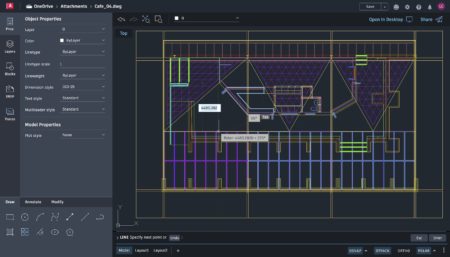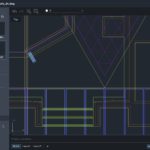PROJECT COLLABORATION DOESN’T need to be so painful. And Autodesk has addressed this with its recently announced new offering, AutoCAD Web—a standalone subscription that offers both AutoCAD on the Web and on mobile as a single affordable product offering.
“AutoCAD Web is for customers that need to transform their business to be more digital and enable their distributed workforce,” says Dania El Hassan, Director of Product Management, AutoCAD.
The New Normal
Initially launched in the summer of 2020, AutoCAD Web technologies helped millions of customers adjust to the global COVID-19 pandemic. However, today the current product offering reflects a mature refinement of how remote work actually functions and how businesses in both AEC and manufacturing have adapted to the “new normal.”
Construction professionals spend a lot of time in the field, so they really benefit from AutoCAD Web to take precise measurements, verify dimensions, make quick edits, and mark up drawings even when offline.
That new normal means project professionals and their project stakeholders seek and expect anywhere, any device access to their project data. And companies today are busier than ever and seeking streamlined methods of getting all participants to impart their expertise and roles no matter where they are. “AutoCAD Web empowers our customers to access collaborative workflows that bring teams together to review and edit their CAD drawings no matter where they are,” adds El Hassan. “Users can view, edit, and share drawings from their browser or mobile device without the need to install any software.”
AutoCAD Web In Action
Users log in to the software via their Google Chrome or Mozilla Firefox browser on either Windows or Mac computers. Their DWG files can then be opened from Autodesk Drive, Autodesk Docs, or one of several leading cloud storage providers such as Microsoft OneDrive, Box, Dropbox, and Google Drive.

Dania El Hassan, Director of Product Management, AutoCAD, Autodesk. (Image: Autodesk / All Rights Reserved).
AutoCAD Web provides core AutoCAD technology so that users can review, edit, and even create drawings for concept and feedback. Users can access block technology and utilize external references. And AutoCAD Web supports the powerful Trace layer technology so users can review and add feedback directly to the drawing (not a PDF) without altering the existing file. The user or teammates can then act on the Trace layer’s content by incorporating, revising, or editing at their discretion.
Autodesk’s Trace technology functions similarly to actual trace paper, functioning in the same spirit. All of AutoCAD’s common tools can be used on the Trace layer, offering a safe, non-destructive layer where others can collaborate. And because Trace is also featured in AutoCAD mobile versions, this technology is ideal for folks working out in the field.
“We have seen experienced engineers, project managers, and CAD and BIM managers use the applications to review, markup, and provide valuable feedback directly into the drawing,” says Dania El Hassan. “Construction professionals spend a lot of time in the field,” she adds, “so they really benefit from AutoCAD Web to take precise measurements, verify dimensions, make quick edits, and mark up drawings even when offline.”

AutoCAD Web the subscription includes AutoCAD mobile apps so users can stay in touch with AutoCAD workflows no matter where they are. (Image: Autodesk / All rights reserved)
That last point is a crucial one. One cannot always count on solid Internet access at AEC job sites. Readers need to understand two aspects of AutoCAD Web’s Trace features. Firstly, multiple participants can draw into the Trace layer and add feedback and propose edits. Secondly, the Trace layer also enables those collaborators to add their feedback directly within the drawing file for greater context. From this perspective, the Trace feature acts as a feedback resolution triage space.
Modern Workflows
Modern workflows demand flexibility on all fronts, from how the software works to how users gain access to their tools and data. And speaking of modern, AutoCAD technology is some of the most current software code in the CAD industry, leveraging state-of-the-art agile development and fully leveraging the latest operating system technologies from Microsoft, Apple and Google.
The new inclusion of AutoCAD mobile versions with AutoCAD Web subscription means that stakeholders who need access to AutoCAD but don’t need to author AutoCAD files themselves have a multi-device onramp that is both cost-effective, affordable, and flexible.

Users of AutoCAD Web can measure and take dimensions and take comparisons from the field or factory floor.
“We’ve seen customers across all phases of the lifecycle use AutoCAD for everything from concept sketches, suggested design changes, as-built drawings, and maintenance of equipment and buildings,” says El Hassan. “It’s fast, efficient, and gets the job done for busy professionals.”
Our Closing Thoughts
By enabling direct markup attached to the CAD drawing in the Trace layer, collaborators can provide rapid feedback loops to AutoCAD authors back in the office and other stakeholders in the field. This is a more streamlined and faster process than PDF-based collaborative workflows and a must-test compelling option for firms with dominant DWG-based CAD technology workflows.

AutoCAD Web is ultimately about collaboration technologies that democratize CAD data to all users and stakeholders, meeting them where they are on their terms and on their devices. (Image: Autodesk / All rights reserved)
The new subscription offering will likely boost and drive AutoCAD usage vis-a-vis new classes of users who are instrumental to CAD-driven projects in AEC and manufacturing but yet don’t know AutoCAD itself.
When we look at how collaboration is taking place today and witness so many first-generation computing practices, it only makes sense that these folks, in particular, consider all-digital practices. What Autodesk is offering is a streamlined collaboration and CAD workflow that ties together all stakeholders regardless of what computing devices they use.







Reader Comments
Folks maybe wondering what is different about AutoCAD Web and AutoCAD LT. In particular, the literature on Autodesk’s website about AutoCAD Web may not be as clear as it could be about one crucial item: can you create a new drawing in AutoCAD Web? The answer is “Yes.” And AutoCAD Web even supports Blocks and Xrefs, plus the Trace Layer technologies.
What you cannot do with AutoCAD Web that you can do with AutoCAD LT is work with data from Microstation DGN files, and attach and import data from PDF files. And there is just one streamlined interface, whereas in AutoCAD LT you can customize your tool palettes, etc.
AutoCAD Web is not a full version of AutoCAD in either LT or full version. It is a dedicated version meant to run alongside AutoCAD on the desktop for users who are not at their main computer or for users who only need to collaborate with AutoCAD users. (think general contractor for example).
Comments are closed.